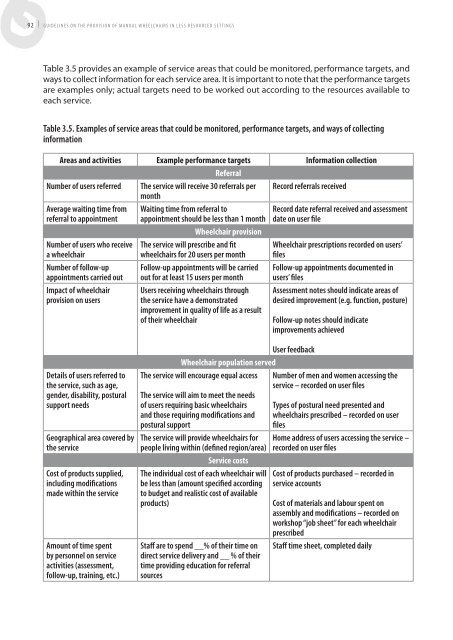Manual Wheelchairs - World Health Organization
Manual Wheelchairs - World Health Organization
Manual Wheelchairs - World Health Organization
Create successful ePaper yourself
Turn your PDF publications into a flip-book with our unique Google optimized e-Paper software.
92 I guIdelInes on the provIsIon of manual wheelchaIrs In less resourced settIngs<br />
Table 3.5 provides an example of service areas that could be monitored, performance targets, and<br />
ways to collect information for each service area. It is important to note that the performance targets<br />
are examples only; actual targets need to be worked out according to the resources available to<br />
each service.<br />
Table 3.5. examples of service areas that could be monitored, performance targets, and ways of collecting<br />
information<br />
Areas and activities Example performance targets<br />
Referral<br />
Information collection<br />
number of users referred The service will receive 30 referrals per<br />
month<br />
record referrals received<br />
Average waiting time from<br />
referral to appointment<br />
number of users who receive<br />
a wheelchair<br />
number of follow-up<br />
appointments carried out<br />
Impact of wheelchair<br />
provision on users<br />
Details of users referred to<br />
the service, such as age,<br />
gender, disability, postural<br />
support needs<br />
geographical area covered by<br />
the service<br />
Cost of products supplied,<br />
including modifications<br />
made within the service<br />
Amount of time spent<br />
by personnel on service<br />
activities (assessment,<br />
follow-up, training, etc.)<br />
Waiting time from referral to<br />
appointment should be less than 1 month<br />
Wheelchair provision<br />
The service will prescribe and fit<br />
wheelchairs for 20 users per month<br />
Follow-up appointments will be carried<br />
out for at least 15 users per month<br />
Users receiving wheelchairs through<br />
the service have a demonstrated<br />
improvement in quality of life as a result<br />
of their wheelchair<br />
User feedback<br />
Wheelchair population served<br />
The service will encourage equal access<br />
The service will aim to meet the needs<br />
of users requiring basic wheelchairs<br />
and those requiring modifications and<br />
postural support<br />
The service will provide wheelchairs for<br />
people living within (defined region/area)<br />
Service costs<br />
The individual cost of each wheelchair will<br />
be less than (amount specified according<br />
to budget and realistic cost of available<br />
products)<br />
Staff are to spend __% of their time on<br />
direct service delivery and __ % of their<br />
time providing education for referral<br />
sources<br />
record date referral received and assessment<br />
date on user file<br />
Wheelchair prescriptions recorded on users’<br />
files<br />
Follow-up appointments documented in<br />
users’ files<br />
Assessment notes should indicate areas of<br />
desired improvement (e.g. function, posture)<br />
Follow-up notes should indicate<br />
improvements achieved<br />
number of men and women accessing the<br />
service – recorded on user files<br />
Types of postural need presented and<br />
wheelchairs prescribed – recorded on user<br />
files<br />
Home address of users accessing the service –<br />
recorded on user files<br />
Cost of products purchased – recorded in<br />
service accounts<br />
Cost of materials and labour spent on<br />
assembly and modifications – recorded on<br />
workshop “job sheet” for each wheelchair<br />
prescribed<br />
Staff time sheet, completed daily

















